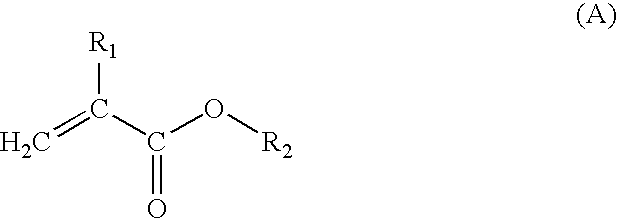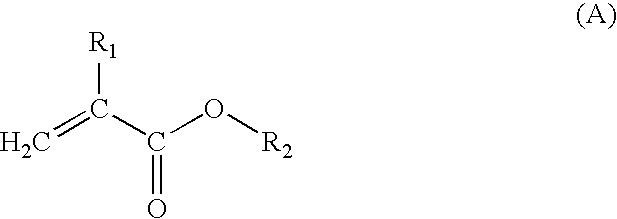Adhesine
a technology applied in the field of adhesives and optical laminates, can solve the problems of insufficient durability and clouding on the surface of glass plates, and achieve the effects of enhancing durability, suppressing white defects, and enhancing reworkability
- Summary
- Abstract
- Description
- Claims
- Application Information
AI Technical Summary
Benefits of technology
Problems solved by technology
Method used
Image
Examples
synthetic example 1
[0089] Into a reactor equipped with a cooler, a tube for inducing nitrogen gas, a thermometer and an agitator, a mixed solution of 81.8 parts of acetone, 98.9 parts of butyl acrylate (hereinafter, abbreviated as EA) as a monomer (A) and 1.1 parts of acrylic acid (hereinafter abbreviated as AA) as a monomer (B) was charged, and then, under being purging oxygen in the reactor by replacing the air therein with nitrogen gas, the mixture in the reactor was heated up to 55° C., and then added with whole portion of a solution prepared by dissolving 0.14 parts of azobisisobutyronitrile (hereinafter, abbreviated as AIBN) in 10 parts of acetone. When 1 hour passed after addition of the initiator, the mixture in the reactor was maintained at 54 to 56° C. for 12 hours under continuously being added with acetone in a rate of 17.3 parts by weight / hour to adjust the concentration of an acrylic resin excluding monomers thereof to 35% by weight, and then finally added with ethyl acetate to adjust th...
synthetic example 2
[0090] Into a reactor same as applied in Example 1, a mixed solution of 208 parts of acetone, 210 parts of butyl acrylate as a monomer (A) and 2.5 parts of acrylic acid as a monomer (B), and then, under being purging oxygen in the reactor by replacing the air therein with nitrogen gas, the mixture in the reactor was heated up to 55° C., and then added with whole portion of a solution containing 0.15 parts of 2,2′-azobis(2,4-dimethylvaleronitrile) and 5 parts of acetone. Thereafter, the mixture in the reactor was reacted at 55° C. for 11 hours to complete polymerization. The polystyrene-reduced weight-average molecular weight determined by the GPC was 768,000 and Mw / Mn was 3.2.
synthetic example 3
[0091] Into a reactor same as applied i n Example 1, a mixed solution of 222 parts of ethyl acetate, 35 parts of butyl acrylate, 44 parts of butyl methacrylate, 20 parts of methyl acrylate as a monomer providing the structural unit (a) and 1 part of hydroxyethyl acrylate as a monomer providing the structural unit (b), and then, after replacing the air in the reactor with nitrogen gas, the mixture in the reactor was heated up to 75° C. After being added with whole portion of a solution prepared by dissolving 0.55 parts of AIBN in 12.5 parts of ethyl acetate, the mixture in the reactor was under being kept at 69 to 71° C. maintained at 69 to 71° C. for 8 hours to complete the reaction. The polystyrene-reduced weight-average molecular weight determined by the GPC was 90000 and Tg was −13° C.
PUM
| Property | Measurement | Unit |
|---|---|---|
| temperature | aaaaa | aaaaa |
| temperature | aaaaa | aaaaa |
| thick | aaaaa | aaaaa |
Abstract
Description
Claims
Application Information
 Login to View More
Login to View More - R&D
- Intellectual Property
- Life Sciences
- Materials
- Tech Scout
- Unparalleled Data Quality
- Higher Quality Content
- 60% Fewer Hallucinations
Browse by: Latest US Patents, China's latest patents, Technical Efficacy Thesaurus, Application Domain, Technology Topic, Popular Technical Reports.
© 2025 PatSnap. All rights reserved.Legal|Privacy policy|Modern Slavery Act Transparency Statement|Sitemap|About US| Contact US: help@patsnap.com



